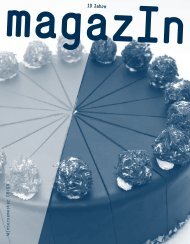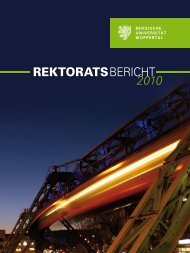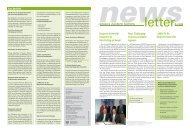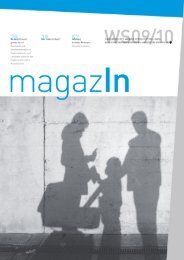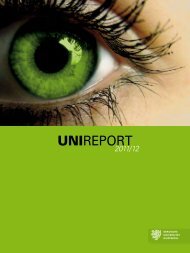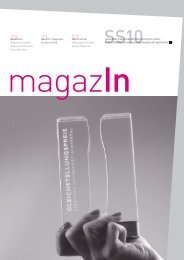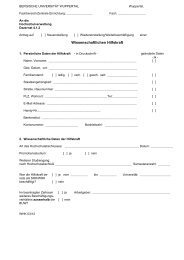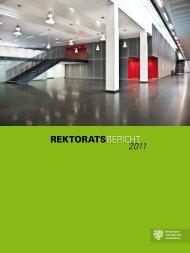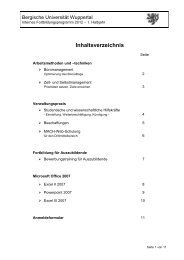international - Bergische Universität Wuppertal
international - Bergische Universität Wuppertal
international - Bergische Universität Wuppertal
You also want an ePaper? Increase the reach of your titles
YUMPU automatically turns print PDFs into web optimized ePapers that Google loves.
164<br />
UW history//milestones<br />
1972<br />
Foundation of the University of <strong>Wuppertal</strong><br />
(UW) as one of five new Gesamthochschulen<br />
(practically oriented ‘comprehensive’ universities)<br />
in NRW (State of North Rhine-Westphalia).<br />
Existing <strong>Wuppertal</strong> higher education institutes<br />
such as the Schools of Engineering and<br />
Industrial Art, as well as the <strong>Wuppertal</strong> branch<br />
of the Rhineland College of Education, are integrated<br />
into the new university structure and<br />
expanded.<br />
1980<br />
UW is the first Gesamthochschule to gain funding<br />
from the German Research Foundation<br />
(DFG) for a collaborative research project: the<br />
School of Chemistry’s “Quantum Theoretical<br />
and Experimental Investigation of the Energy<br />
State of Simple Molecules”.<br />
The official title of UW is now “<strong>Universität</strong> –<br />
Gesamthochschule”.<br />
1983<br />
UW mathematician Professor Dr. Gerd Faltings,<br />
at 28 Germany’s youngest mathematics<br />
professor, receives the Fields Medal, an honor<br />
on a par with a Nobel Prize.<br />
The official title of UW is now “<strong>Bergische</strong> Uni-<br />
versität – Gesamthochschule <strong>Wuppertal</strong>“.<br />
1987<br />
Spiegel editor Rudolf Augstein is awarded an<br />
honorary doctorate.<br />
1989<br />
The university launches its biggest research<br />
project to date: investigation of the Earth’s<br />
upper atmosphere. The project (1989-2000)<br />
attracts external funding totaling almost DM<br />
55m.<br />
1990<br />
october 17: UW physicists and mathematicians<br />
start up their new parallel computer – a<br />
machine with more than 8000 processors – in<br />
the University Computing Center.<br />
1994<br />
UW’s space probe CRISTA is launched in November<br />
on NASA’s ‘Atlantis’ space shuttle.<br />
The probe will measure trace gases in the<br />
shuttle’s orbit.<br />
1995<br />
The university is growing: work starts on the<br />
new Freudenberg Campus just up the hill from<br />
the main Grifflenberg Campus.<br />
1999<br />
Europe’s Ministers of Education agree in Bologna<br />
to develop new consecutive degree programs<br />
on the Anglo-American BA/MA model.<br />
2000<br />
First bachelor’s and master’s programs start<br />
at UW.<br />
2001<br />
In his function as mediator, Prof. Dr. Hans Weiler<br />
develops a concept for the enhancement<br />
of the university’s profile.<br />
2002<br />
UW Rector Volker Ronge and Prof. Dr. Hans<br />
Weiler submit the final ‘Mediation Report’ to<br />
the North Rhine-Westphalian Minister of Science<br />
and Research, Gabriele Behler. Reduction<br />
of the number of faculties from 13 to 7<br />
will concentrate the university’s strengths and<br />
form the basis for a clear up-to-date profile.<br />
2003<br />
The term Gesamthochschule is abolished and<br />
UW’s official title is now ‘<strong>Bergische</strong> <strong>Universität</strong><br />
<strong>Wuppertal</strong>’.<br />
2004<br />
Installation of the supercomputer AliCEnext –<br />
at the time the most powerful in any German<br />
university.<br />
opening of the first three Interdisciplinary<br />
Research Centers: Applied Informatics and<br />
Scientific Computing, Technical Process Management,<br />
and Polymer Technology.<br />
2006<br />
June 14: UW Senate resolves to introduce tuition<br />
fees.<br />
2007<br />
NRW Academic Freedom Act comes into<br />
force on January 1, granting the universities<br />
greater autonomy and responsibility. on the<br />
basis of the new Act, UW and the State of<br />
NRW conclude the third Target Agreement,<br />
which determines among other things that<br />
subjects in great demand will be enlarged and<br />
extended.<br />
Members of UW’s first Supervisory Board are<br />
appointed by the Minister of Science and Research.<br />
<strong>Wuppertal</strong> astrophysicists take part in the<br />
world’s biggest experiment: the 3000 sq km<br />
Pierre Auger observatory in Argentina, dedicated<br />
to the investigation of black holes and<br />
allied phenomena.<br />
2008<br />
Prof. Dr. Lambert T. Koch is installed as sixth<br />
Rector in the 36-year history of UW, succeeding<br />
Prof. Dr. h. c. Volker Ronge (1999-2008),<br />
Prof. Dr. Dr. h. c. Erich Hödl (1991-1999),<br />
Professor Dr. Dr. h. c. Siegfried Maser (1987-<br />
1991), Prof. Dr. Josef M. Häussling (1983-<br />
1987) and the Founding Rector Prof. Dr. Dr. h.<br />
c. Rainer Gruenter (1972-1983).<br />
The Faculty of Economics takes the additional<br />
name ‘Schumpeter School of Business and<br />
Economics’.<br />
The German Research Foundation (DFG) sets<br />
up a joint collaborative research project on<br />
“Hadron Physics from Lattice QCD” at UW<br />
and the University of Regensburg.<br />
165<br />
10_UW_PFACTS



